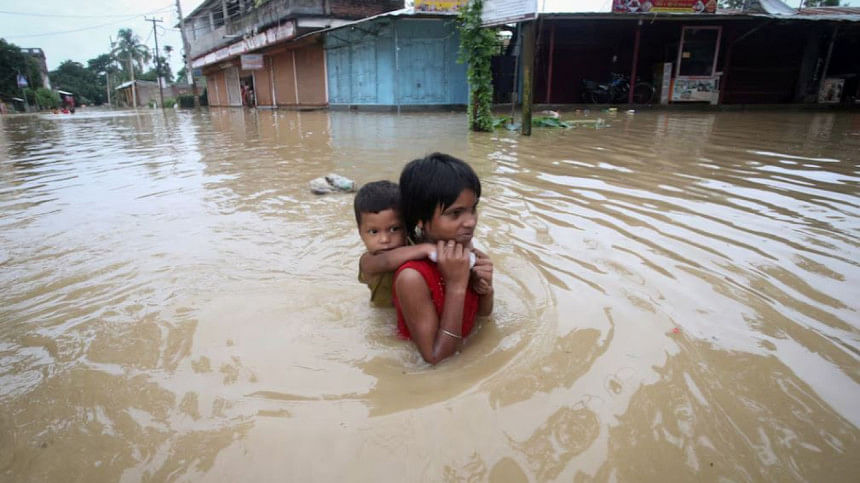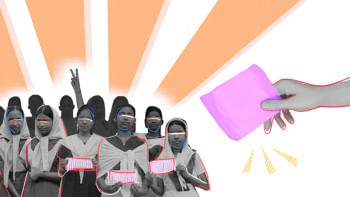Why can't we prevent drowning fatalities?

Annually, approximately 19,000 people of all ages lose their lives to drowning in Bangladesh. And while adults—particularly those aged 60 or older—face substantial risk of drowning, children are its primary victims. In fact, drowning is the leading cause of death among children aged 1-4 years. They are three times more likely to drown than those aged 10-17 years.
The prevalence of this crisis in our country is not random; it is shaped by a confluence of demographic, environmental, socioeconomic, and behavioural factors. Geographically and environmentally, Bangladesh's landscape—characterised by vast floodplains and water bodies—presents inherent risks. The majority of drownings, approximately 80 percent, occur in ponds, channels, buckets, drains, and ditches located within 20 metres of a child's home. Rural areas, particularly those prone to yearly floods and waterlogging, present a higher risk. A critical observation is that the very practice of constructing homes on elevated land to mitigate flooding often results in excavated pits that transform into accessible ditches and ponds adjacent to residences, inadvertently creating immediate hazards. Paradoxically, in such cases, the most dangerous water bodies are not distant rivers or oceans, but rather the seemingly innocuous water sources right next to homes.
Most drowning incidents (95 percent) occur between 9 am and 3 pm, especially during the monsoon. This critical six-hour window often coincides with peak hours when parents and caregivers are busy with household chores or agricultural work, resulting in insufficient supervision of young children.
Drowning deaths are disproportionately higher among the poorest and least educated populations in rural settings. Low economic status often compels parents to work long hours, leading to a lack of consistent adult supervision for their children. Parental illiteracy, particularly among mothers, is strongly associated with a significantly higher risk of both fatal and non-fatal drowning, as it correlates with poorer water safety awareness and limited access to prevention knowledge. This suggests that the high drowning rates are not merely an issue of water exposure, but are symptomatic of broader socioeconomic vulnerabilities and a lack of access to resources that could ensure child safety.
Behavioural factors also play a critical role. A staggering 97 percent of child drowning victims did not know how to swim. Furthermore, some communities hold fatalistic beliefs, attributing drowning to divine will, which can inadvertently foster passive attitudes towards proactive prevention efforts.
The true scale of the drowning crisis in Bangladesh is likely even higher than reported. There is currently no official, comprehensive system to track drowning cases nationwide. NGOs often compile drowning data based on media reports, but this method captures only a fraction of actual incidents, as most cases go unnoticed and unreported. Additionally, nationwide surveys on drowning incidents are not conducted regularly, leading to potential underestimation and challenges in precise policy planning and resource allocation.
Despite the formidable scale of this crisis, Bangladesh has been leading efforts to develop and implement evidence-based strategies that offer significant hope. The Centre for Injury Prevention and Research, Bangladesh (CIPRB), in collaboration with international partners such as Bloomberg Philanthropies, Johns Hopkins University, and UNICEF, has pioneered and rigorously evaluated highly effective, context-specific interventions. These interventions have garnered global recognition and have been endorsed by the World Health Organization as best practices for low- and middle-income countries (LMICs).
One of the most impactful interventions is the establishment of community-based childcare centres—Anchal Creche. These centres provide safe, supervised environments for children aged 1-5 years during the critical morning hours, six days a week. In some areas where community crèches were opened, drowning rates fell by as much as 70 percent.
The SwimSafe programme targets older children, typically aged 6-10 years, teaching them essential survival swimming skills. This intervention has been shown to reduce the chances of drowning by an impressive 90 percent.
A major turning point in Bangladesh's fight against drowning occurred in February 2022, when the government approved a substantial $32 million, three-year "Integrated Community Based Centre for Childcare and Protection, Women Enlightenment and Swim-Safe Facilities Project". This ambitious project aims to establish 8,000 community-based childcare centres to enrol 200,000 children aged 1-5 years and teach survival swimming skills to 360,000 children aged 6-10 years between 2022 and 2024.
The government's commitment extends to transitioning responsibility for existing crèches (2,198 centres) to the Bangladesh Shishu Academy, the lead agency for this project.
Despite the significant strides made and the proven effectiveness of interventions, several challenges persist in the fight against drowning. A primary concern is the existing gap between high-level global advocacy and comprehensive national implementation. A rigorous, countrywide drive to boost awareness and a fully integrated national strategy for drowning prevention remain either unfocused or nascent. Unfortunately, high-level commitment does not automatically translate into robust, widespread national policies and infrastructure. Moreover, insufficient epidemiological surveillance disempowers effective prevention efforts.
There is also a common tendency to delay swim education, missing a critical window for skill acquisition. Compounding these issues are fatalistic beliefs, where drowning is perceived as an unavoidable fate. However, the demonstrated success of community-based interventions—such as crèches and swimming lessons—can directly challenge and erode these fatalistic views. When communities witness tangible results—children returning safely from childcare centres or acquiring life-saving swimming skills—it shifts the perception from "unavoidable tragedy" to "preventable risk".
The interventions, while effective, need to specifically target and reach the poorest and least educated communities, who face the greatest barriers to accessing such services.
Drowning prevention necessitates a coordinated effort involving various government ministries (e.g., women and child affairs, health, and local government), NGOs, community groups, and international partners. Reframing drowning as an integral part of broader child safety and development—rather than a niche issue—is essential to secure wider leadership, sustained investment, and comprehensive policy integration.
Implementing a robust national epidemiological surveillance system is critical. While Bangladesh has championed global resolutions, there is a clear need to translate these international commitments into stronger national policies and potentially specific safety legislation.
The statistics paint a grim picture, yet the proven effectiveness of community-based childcare, survival swimming, and first aid interventions offers hope. Bangladesh has demonstrated both the severity of the challenge and a remarkable capacity for developing and implementing impactful solutions. Saving lives from drowning is a shared responsibility. By prioritising and scaling up evidence-based programmes, strengthening policy frameworks, and fostering a pervasive culture of water safety, Bangladesh can protect its children from this preventable tragedy.
Sifat Afrin Shams is a member of the editorial team at The Daily Star.
Views expressed in this article are the author's own.
Follow The Daily Star Opinion on Facebook for the latest opinions, commentaries and analyses by experts and professionals. To contribute your article or letter to The Daily Star Opinion, see our guidelines for submission.

 For all latest news, follow The Daily Star's Google News channel.
For all latest news, follow The Daily Star's Google News channel. 





Comments